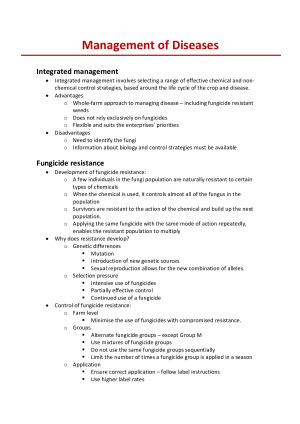H1 (92) Plant Pathology AGRI30042
Subject notes for UniMelb AGRI30042
Description
There was quite a lot of jargon and examples throughout this subject, which I have included throughout these notes in a condensed format. These notes include hand-drawn images and information about the following content; Introduction What is plant pathology? Causal agents of disease Symptoms of plant diseases Classification of plant diseases Disease triangle Post-Harvest Disease Post-Harvest Disease Overview Method of Fungi infection in fruit and vegetables Control of post-harvest disease Emerging technologies for control Food safety and Mycotoxins Paspalum Staggers in cattle Perennial Ryegrass toxicosis, or Ryegrass Staggers Bacterial post-harvest diseases Fungi Fungi Specific Definitions General characteristics of Fungi Reproduction of Fungi Phylogenetic tree of fungi The Five Phyla of fungi Summary of the groups of fungi Zygomycota Zygomycota specific terms Characteristics of Zygomycota Examples of disease caused by Zygomycota Ascomycota Ascomycota Jargon Ascomycota Characteristics Ascocarps Naked asci example – Peach leaf curl Cleistothecia (round ascocarp) example – Powdery Mildew Apothecia (Whale tail) example Perithecia (flask) Example Pseudothecia Basidomycota Basidiomycota jargon Background info on Basidiomycota Characteristics of Basidiomycota Sexual Reproduction of Basidomycota Clamp connections Plant pathogens in the phylum Basidiomycota Rusts (pucciniomycotinia) Examples of rusts Smuts (Ustilaginomycotina) Examples of Smuts Control of cereal smuts Roots and wood rots (Agaricomycotinia) Examples of Wood root Polypores Fungal Pathogen Taxonomy Importance of the correct identification of pathogens Issues affecting fungal taxonomy (identification) Type specimen Molecular taxonomy of fungal plant pathogens PCR – polymerase chain reaction – process Bioinformatics NCBI GenBank Database Phylogenetics Case study – chilli anthracnose Plant Diseases Caused by viruses Virus structure Virus detection Virus movement within host How viruses can cause disease Virus symptoms Virus transmission Insect transmission Control of viruses Properties used to distinguish viruses Virus replication strategies Single stranded RNA virus replication Virus replication (RNA Virus) – doubtful on the exam Classification of plant viruses Potyviruses Examples of plant viruses Viruses of biosecurity threat to Australia Plant Diseases caused by bacteria Introduction Bacterial taxonomy Gram stain Gram strain technique Gram +ve bacteria Gram -ve bacteria Identification of bacteria Biochemical tests Plant pathogenicity Infraspecfic groups Spread of bacteria Control Symptoms of bacterial pathogen in plants Examples of bacteria caused plant diseases Soil borne plant pathogens The soil environment Microbiomes Rhizosphere Information about soil pathogens Fungistasis Plant parasitic nematodes Nematode-Pathogen interactions Potato Early Dying syndrome Yield decline in field crops Soil borne pathogen management Soil-borne pathogens Key characteristics of soil-borne pathogens Why is it hard to control soil-borne pathogens? Control approach of soil-borne pathogens Soil disinfestation Organic amendments Biological control agents Pseudofungi Pseudofungi Overview Kingdom Protozoa Phylum Plasmodiophoromycota: Club foot of Brassica (). Phylum Plasmodiophoromycota: Powdery scab of potato (Spongospora subterranean) Kingdom Chromista – Phylum Oomycota Fishing for oomycetes – soil baiting Oomycota vs. Fungi Oomycetes as plant pathogens Phylum Oomycetes. Order Pythiales. Genus Pythium spp. Phylum Oomycetes, Order Peronosporales, Genus Phytophthora spp. Late blight of potatoes – Phytophthora infestans Phytophythora dieback of native forests in Australia (Phytophthora cinnamomic) Phylum: Oomycete. Order: Peronosporales. Name: Downy mildew Downy mildew of grape vines (Plasmopara viticola) Phylum Oomycete. Order Albuginales. White blister rust of brassica (Albugo candida) Pathogen Diversity Importance of examining pathogen diversity Factors affecting genetic diversity Mechanisms of pathogen diversity Assessing pathogen diversity Morphological markers Molecular markers Detection of pathogenic diversity Pathotype Aggressiveness Case study – diversity of Colletotrichum truncatum Case study – diversity of Colletotrichum truncatum Plant Pathogen diagnosis Plant pathogen diagnosis Means of diagnosis/identification Koch’s postulates Fungi Bacteria Viruses Diagnostic test Serological test DAS-ELISA (DAS = Double antibody sandwich) Tissue blot immunoassay (TBIA) Nucleic acid (DNA) - based diagnostic tests ELISA vs DNA techniques Quantitative PCR Case-study – Stagonosporopsis tanaceti in pyrethrum seed Biosecurity Plant biosecurity Importance of biosecurity Biosecurity in Australia Surveillance Import Risk Analyses Compliance and certification Emergency Plant Pests (EPPs) EPP incident response Domestic Quarantine Case study – Khapra beetle Case study – Potato Cyst Nematode Case study – Grape Phylloxera Authorised inspectors Genetics of plant resistance Types of resistance Breeding for disease resistance Gene for gene hypothesis Race-specific/ Vertical resistance Race non-specific / horizontal resistance Comparison of race-specific vs non-specific Horizontal and Vertical resistance Potential for pathogen to overcome resistance Infection and pathogenesis Definitions: Life cycle and disease cycle Stages in a disease cycle Classes of infectious fungi Infection phases of Colletotrichum spp. Endophytic infection Host-pathogen interactions Host-pathogen relationship Complex interaction between pathogen and host Pathogen invasion Identification of specific genes involved in infection process – example Toxins produced by the pathogen Host response Host defence Antimicrobial substances – induced Resistance mechanisms Management of diseases Integrated management Fungicide resistance Application of fungicides – methods Integrated management and the disease triangle Integrated Management of Barley Powdery Mildew (Blumeria graminis) Barley powdery mildew in WA Integrated Management of Grape Powdery Mildew Measuring disease Purpose of Disease Measurement Procedure to Measure impact of disease Disease assessment scales – severity Measuring Root Diseases Critical Point Model Area under disease progress curve model Epidemiology Epidemiology Factors influencing Epidemics Disease progress curves Epidemic rates and disease curves Effect of vertical vs Horizontal resistance on epidemics Forecasting plant disease epidemics
UniMelb
Semester 1, 2021
114 pages
25,973 words
$39.00
8
Campus
UniMelb, Parkville
Member since
February 2018
- Fundamentals of Chemistry CHEM10007 Detailed H1 Notes
- Companion Animal Biology - Detailed H1 notes
- H1 (87) Ecology and Grazing Management AGRI20036 Clear and Concise notes
- H1 (85) Principles of soil science AGRI20038 Clear and Concise notes
- H1 (88) Food for a healthy plant 2 (UNIB20014) notes
